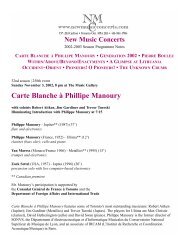2004-2005 Season The Hammerhead Consort - New Music Concerts
2004-2005 Season The Hammerhead Consort - New Music Concerts
2004-2005 Season The Hammerhead Consort - New Music Concerts
You also want an ePaper? Increase the reach of your titles
YUMPU automatically turns print PDFs into web optimized ePapers that Google loves.
PAUL STEENHUISEN (Canada 1965) Material/Ultramaterial<br />
CBC/Laidlaw Commission for ensemble and sound files (<strong>2005</strong>)<br />
Paul Steenhuisen was raised in Vancouver by parents from <strong>The</strong> Netherlands and Curaçao. <strong>The</strong> confluence of<br />
his heritage and upbringing in North American culture has informed both his education and musical output. In<br />
addition to earning his doctoral degree from the University of British Columbia under the direction of Keith<br />
Hamel, Paul Steenhuisen studied with Louis Andriessen at the Royal Conservatory of <strong>Music</strong> in the Hague,<br />
privately with Michael Finnissy in London, England, and with Tristan Murail at IRCAM (Centre Georges<br />
Pompidou, Paris). Between 1998 and 2000, Paul Steenhuisen was composer in residence with the Toronto<br />
Symphony Orchestra, and in 2003, he was appointed Assistant Professor of Composition at the University of<br />
Alberta.<br />
During his student years, Steenhuisen was laureate of many national and international composition<br />
competitions, including 4 awards in the CBC Young Composers competition, 7 awards in the<br />
PROCAN/SOCAN competition, 1st prize in the Vancouver <strong>New</strong> <strong>Music</strong> competition, and as finalist in the<br />
Gaudeamus Competition (Netherlands). He was also awarded the Governor General of Canada Gold Medal as<br />
the outstanding student in all faculties at the University of British Columbia. Since that time, Steenhuisen has<br />
been active internationally, at festivals and on radio. His music has also been performed at each of the major<br />
Canadian festivals, including the Sound Symposium, Montreal Nouvelles Musique, the Massey Hall <strong>New</strong><br />
<strong>Music</strong> Festival, Open Ears, <strong>The</strong> Winnipeg <strong>New</strong> <strong>Music</strong> Festival, and the Vancouver International <strong>New</strong> <strong>Music</strong><br />
Festival. Performances at other international festival include those in Adelaide, Sydney, Darmstadt, Ought One<br />
(Vermont), and Three-Two (<strong>New</strong> York), while on radio, his music is regularly performed in Europe, Asia,<br />
Australia, and North America. Paul Steenhuisen serves on the executive of the Canadian League of<br />
Composers, is president of the Canadian Section of the ISCM, and is a member of the Morningstars Hockey<br />
Club. He is also a regular contributor to <strong>The</strong> Wholenote magazine.<br />
Figuring prominently in Islamic art, the mosaic is formed using small tiles and random or filed chips of<br />
contrasting colour, stone, or glass. Islamic mosaic art is designed to express the logic and order inherent in<br />
the Islamic vision of the universe, with patterns and geometry repeated without beginning or end. Islamic<br />
artists sought not to express themselves, but to ennoble matter. In the new millennium, so much has been<br />
broken and taken apart that I feel that everywhere I go, I’m walking on shards of glass, if not broken by me,<br />
then for me, in the name of a Monolith, against a political Mosaic. Ironically, the destruction has produced<br />
countless shards from which devotional mosaics are built.<br />
Using the medium of the immaterial (music), one way of recalibrating my stress concerning the broken has<br />
been to work with it as material. Every note in Material/Ultramaterial is derived from a spectral analysis of<br />
me walking through glass from a broken window. Multiple cross-sections of the sound fragment were dissected<br />
to produce the pitch/chord streams of the primary material, extracting between one and approximately thirty<br />
chords/units, in resolutions between one and twenty notes. In most segments of the music, they are presented in<br />
retrograde.<br />
Beginning from virtual silence, or the soft noise of an aftermath, the piece slowly melts through various forms<br />
of its glass materials, exploring the inherent measured qualities of the glass mostly without specific<br />
representation. <strong>The</strong> work develops into an uncertain dialectical state - reversed broken glass, refusal, and<br />
possibly reconstruction into a weblike mosaic built and dependent upon the fragments it sets out to oppose.<br />
Material/Ultramaterial is the first in a series of progressively fragmentary abstract protest pieces based on the<br />
same spectral source.<br />
— Paul Steenhuisen




